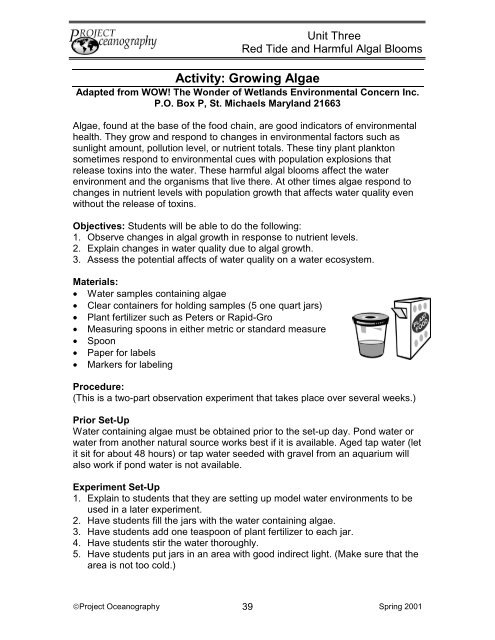Red Tide and Harmful Algal Blooms - College of Marine Science
Red Tide and Harmful Algal Blooms - College of Marine Science
Red Tide and Harmful Algal Blooms - College of Marine Science
Create successful ePaper yourself
Turn your PDF publications into a flip-book with our unique Google optimized e-Paper software.
Unit Three<br />
<strong>Red</strong> <strong>Tide</strong> <strong>and</strong> <strong>Harmful</strong> <strong>Algal</strong> <strong>Blooms</strong><br />
Activity: Growing Algae<br />
Adapted from WOW! The Wonder <strong>of</strong> Wetl<strong>and</strong>s Environmental Concern Inc.<br />
P.O. Box P, St. Michaels Maryl<strong>and</strong> 21663<br />
Algae, found at the base <strong>of</strong> the food chain, are good indicators <strong>of</strong> environmental<br />
health. They grow <strong>and</strong> respond to changes in environmental factors such as<br />
sunlight amount, pollution level, or nutrient totals. These tiny plant plankton<br />
sometimes respond to environmental cues with population explosions that<br />
release toxins into the water. These harmful algal blooms affect the water<br />
environment <strong>and</strong> the organisms that live there. At other times algae respond to<br />
changes in nutrient levels with population growth that affects water quality even<br />
without the release <strong>of</strong> toxins.<br />
Objectives: Students will be able to do the following:<br />
1. Observe changes in algal growth in response to nutrient levels.<br />
2. Explain changes in water quality due to algal growth.<br />
3. Assess the potential affects <strong>of</strong> water quality on a water ecosystem.<br />
Materials:<br />
• Water samples containing algae<br />
• Clear containers for holding samples (5 one quart jars)<br />
• Plant fertilizer such as Peters or Rapid-Gro<br />
• Measuring spoons in either metric or st<strong>and</strong>ard measure<br />
• Spoon<br />
• Paper for labels<br />
• Markers for labeling<br />
Procedure:<br />
(This is a two-part observation experiment that takes place over several weeks.)<br />
Prior Set-Up<br />
Water containing algae must be obtained prior to the set-up day. Pond water or<br />
water from another natural source works best if it is available. Aged tap water (let<br />
it sit for about 48 hours) or tap water seeded with gravel from an aquarium will<br />
also work if pond water is not available.<br />
Experiment Set-Up<br />
1. Explain to students that they are setting up model water environments to be<br />
used in a later experiment.<br />
2. Have students fill the jars with the water containing algae.<br />
3. Have students add one teaspoon <strong>of</strong> plant fertilizer to each jar.<br />
4. Have students stir the water thoroughly.<br />
5. Have students put jars in an area with good indirect light. (Make sure that the<br />
area is not too cold.)<br />
©Project Oceanography 39<br />
Spring 2001
















